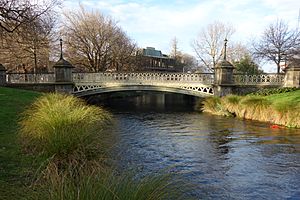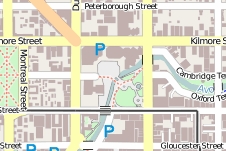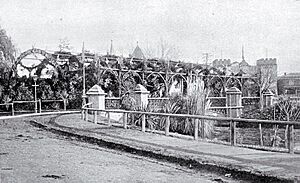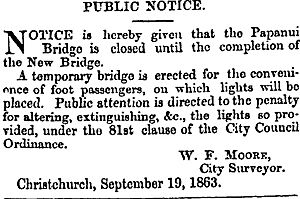Hamish Hay Bridge facts for kids
Quick facts for kids Hamish Hay Bridge |
|
|---|---|

The bridge in 2013
|
|
| Coordinates | 43°31′40″S 172°38′07″E / 43.527778°S 172.635278°E |
| Carries | pedestrians, cyclists |
| Crosses | Avon River |
| Locale | Victoria Square, Christchurch, New Zealand |
| Other name(s) |
|
| Characteristics | |
| Design | cast iron girders |
| Material | steel, concrete deck |
| Width | 20.1 m |
| Number of spans | 1 |
| History | |
| Designer | Charles Fox (London) James Wylde (Christchurch) |
| Constructed by | Edward George Wright |
| Opened | 28 September 1864 |
| Statistics | |
| Daily traffic | none |
| Designated: | 2 April 2004 |
| Reference #: | 1832 |

Victoria Square with surrounding city blocks
|
|
The Hamish Hay Bridge is a special bridge in Victoria Square, Christchurch, New Zealand. It's also known as the Victoria Street Bridge. Before that, it was called the Victoria Bridge, and even earlier, the Papanui Bridge or Market Place Bridge.
This bridge was built way back in 1864. In 1989, it was renamed after Sir Hamish Hay, who was the Mayor of Christchurch. A special bronze plaque on the bridge honors his work for the city. The Hamish Hay Bridge is the oldest historic feature in Victoria Square. It's also the oldest bridge in New Zealand made from cast iron and stone. Even after the big 2011 Christchurch earthquake, the bridge was still standing and undamaged! It has cool architectural details like its arch and fancy neo-gothic decorations. The bridge is officially recognized as a Category II heritage structure by Heritage New Zealand.
Contents
Where is the Hamish Hay Bridge?
When Christchurch was first planned in 1850, it had a grid pattern of streets. But the Avon River and two diagonal roads changed this. One of these diagonal roads crossed the Avon River where a market square was planned.
A simple bridge was built here in March 1852. This was the first bridge in the spot where the Hamish Hay Bridge is now. The road leading to the bridge was first called Whately Road. It was named after an important person from Dublin, Ireland. Later, the road became Victoria Street, and the market square became Victoria Square.
History of the Bridge
The First Bridge (1852)
Christchurch started as a settlement in December 1850. Soon after, a group of land buyers decided to build the first bridge in the market square. This happened in March 1852.
The bridge made it easier to get to the Papanui Bush, which was about 6.5 kilometers away. This bush was one of the only two forests on the Canterbury Plains. It was a very important source of wood for building and for fires. Because of this, the bridge became known as the Papanui Bridge. People also called it the Market Place Bridge, as it was right in the middle of the area known as Market Place.
The Second Bridge (1856)
The first bridge was only wide enough for one cart at a time. So, a new, wider bridge was built in February 1856. This new bridge was about 4.9 meters wide. It took 13 days to build, and the bridge was closed during this time.
In 1862, the Christchurch City Council was formed. But the bridge was still controlled by the Canterbury Provincial Council. This was because the bridge was very important for travel. The Provincial Council decided to replace the bridge again in 1862. They planned to spend £2,000, but later increased the budget.
In 1863, lights were put on the bridges so people could see where they were going at night. But soon after, the Papanui Bridge had to be closed for carts. A temporary footbridge was built for people to cross.
The Present Bridge (1864)
The government hired Sir Charles Fox from London to design a much stronger bridge. He also helped find a company to make the iron parts. These parts were made in England and cost £605. There was a delay because some parts were not made correctly and had to be redone.
Meanwhile, a local engineer named James Wylde worked on the bridge design in Christchurch. The building work was given to Edward George Wright, who won the contract for £2,375. Wright started building in January 1864. The iron parts from England arrived in July, but some were cracked from the rough sea journey. They were repaired locally for over £300.
Wright built strong stone blocks for the iron parts to rest on. The bridge was built to be about 8.4 meters wide. It officially opened on September 28, 1864, with a big ceremony. No one was allowed to cross it before the opening! John Ollivier, who was the chairman of the Christchurch Town Council, broke a bottle of champagne to open it. Dr. William Donald then officially named it Victoria Bridge.
Some people, like the local newspaper The Press, thought the new bridge was too fancy and expensive. But it was built to last! The total cost of the bridge was about £3,410. The Provincial Council gave the Town Council control of the bridge.
In 1868, a big flood hit Christchurch. The Waimakariri River overflowed, and the floodwaters reached the Avon River. Many parts of the city were underwater. Some bridges were washed away or damaged, but the Victoria Bridge survived the flood without any problems!
The bridge was made wider in 1875. New parts were added, and wooden footpaths were built on the sides. In 1877, Whately Road was officially renamed Victoria Street.
Steam trams started using the bridge in 1880, traveling to St Albans and Papanui. In 1885, the bridge was made even wider, reaching its current width of 20.1 meters. This is a common width for main roads in the city center.

In 1901, the Duke and Duchess of Cornwall and York (who later became King George V and Queen Mary) visited Christchurch. Many arches made of greenery were put up to welcome them. The most impressive arch was at Victoria Bridge. It had nine semi-circular arches and was 6.6 meters tall!
The last tram service in Christchurch crossed the bridge on September 10, 1954. Trams were replaced by buses. In July 1989, Victoria Street through Victoria Square was closed to cars. This was to turn the square into a park and build a new hotel. Part of the bridge deck was removed so you could see the old cast iron parts. Old tram tracks were also added to the design to remember the city's transport history. At this time, the bridge was renamed the Hamish Hay Bridge, after the mayor who was leaving office.
The bridge was not damaged by the 2011 Christchurch earthquake.
Heritage Status
The Hamish Hay Bridge is officially listed as a Category II heritage item by Heritage New Zealand. It was registered on April 2, 2004. This means it's a very important historic place.
The bridge is important for many reasons:
- It played a big role in the city's early transport.
- It's connected to several early engineers in Christchurch.
- It was very important when Victoria Square was redeveloped in the 1980s.
- It was the first cast iron bridge in New Zealand.
- It helps us remember the history of Victoria Square, the tram system, and Sir Hamish Hay.
- Its neo-gothic style influenced the design of five other bridges on the Avon River.
On the same day, five other neo-gothic bridges on the Avon River were also registered:
- Colombo Street Bridge (around 1902)
- Armagh Street Bridge (around 1883)
- Gloucester Street Bridge (around 1883)
- Worcester Street Bridge (around 1883)
- Armagh Street Park Bridge (1885)
Geoffrey Rice, a history professor, believes the Hamish Hay Bridge is the most important historic bridge in Christchurch.



